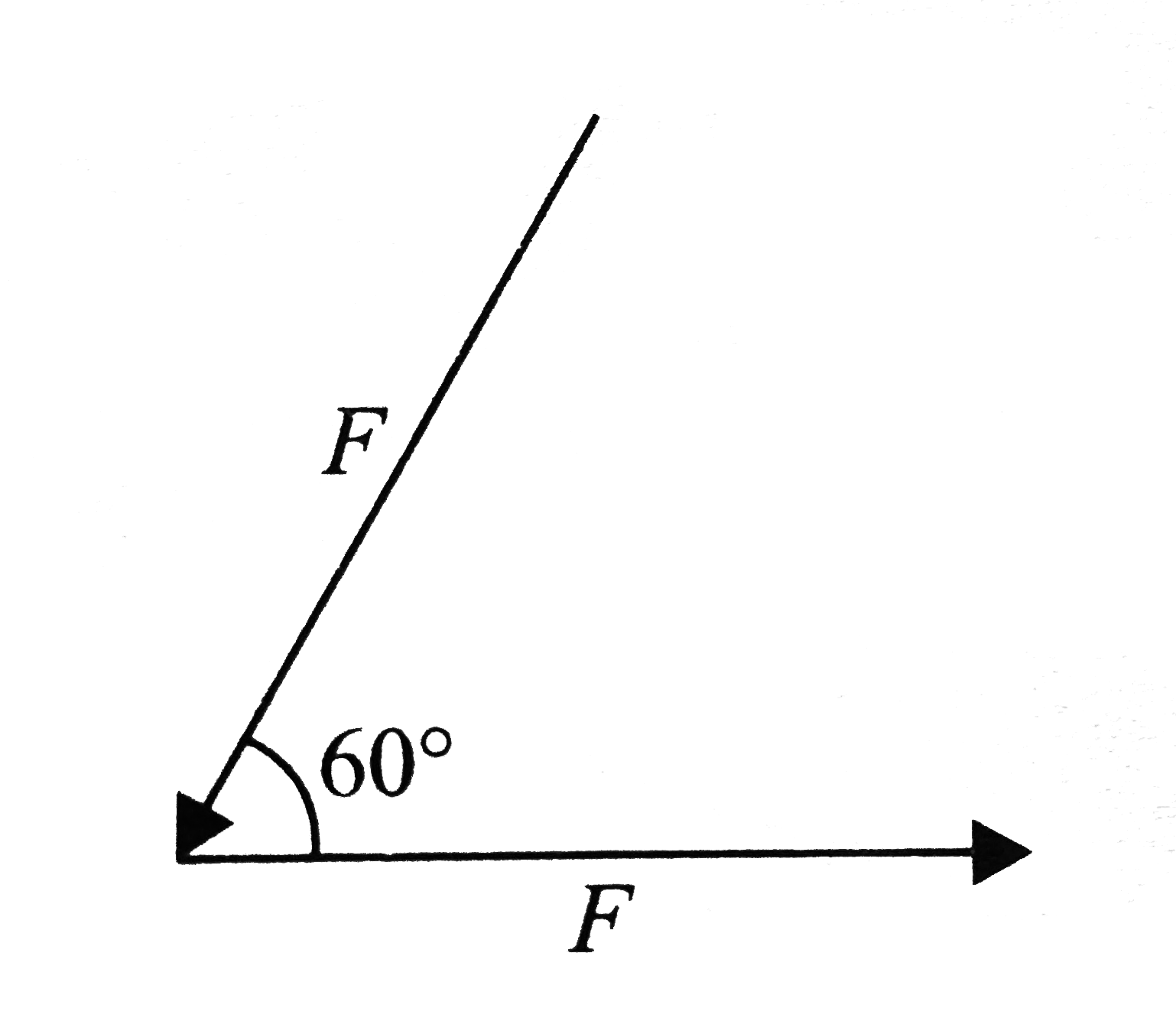Complete Solutions to Resultant Of Vectors of chapter VECTORS of Class 11 book with complete answers and questions
| Class 11 | PHYSICS |
| Chapter | VECTORS |
| A2Z | Resultant Of Vectors |
| Number Of Questions | 24 |
| Academic Year | 2023-24 |
If `|vec(A)+vec(B)|=|vec(A)|=|vec(B)|` then the angle between `vec(A)` and `vec(B)`is
View SolutionThe maximum and minimum magnitude of the resultant of two given vectors are 17 units and 7 unit respectively. If these two vectors are at right angles to each other, the magnitude of their resultant is
View SolutionForces `F_(1) and F_(2)` act on a point mass in two mutually perpendicular directions. The resultant force on the point mass will be
View SolutionTwo forces, each equal to F, act, as shown in figure. Their resultant is

View SolutionWhat is the angle between `vecP` and the resultant of `(vecP + vecQ)` and `(vecP - vecQ)`
View SolutionA force of `6 kg` another of `8 kg` can be applied together to produce the effect of a single force of
View SolutionThe ratio of maximum and minimum magnitudes of the resultant of two vectors `vec(a)` and `vec(b)` is 3:1. Now, `|vec(a)|` is equal to
View SolutionThere are two forces vector,one of 5N and other of 12N. At what angle should the two vector be added to get the resultant vector of 17N, 7N,and 13N respectively?
View SolutionA particle is simultaneously acted by two forces equal to `4 N` and `3N`. The net force on the particle is
View SolutionWhich pair of the following forces will never give resultant force of `2 N`?
View SolutionTwo vectors `vec(A) and vec(B)` lie in plane, another vector `vec(C )` lies outside this plane, then the resultant of these three vectors i.e., `vec(A)+vec(B)+vec(C )`
View SolutionTwo vectors `vec(A) and vec(B)` inclined at an angle `theta` have a resultant `vec(R )` which makes an angle `alpha` with `vec(A)`. If the directions of `vec(A) and vec(B)` are interchanged, the resultant will have the same
View SolutionWhen two vectors of magnitudes P and Q are inclined at an angle `theta`, the magnitudes of their resultant is 2P. When the inclination is changed to `180^(@)-theta`, the magnitude of the resultant is halved. Find the ratio of `P` and `Q`.
View SolutionTwo forces of magnitudes P and Q are inclined at an angle `(theta)`. The magnitude of their resultant is 3Q. When the inclination is changed to `(180^(@)-theta)`, the magnitude of the resultant force becomes Q. Find the ratio of the forces.
View SolutionThe resultant of `vec(A)+vec(B) is vec(R )_(1)`. On reversing the vector `vec(B)`, the resultant becomes `vec(R )_(2)`. What is the value of `R_(1)^(2)+R_(2)^(2)`?
View SolutionTwo vectors `vec(a)` and `vec(b)` are such that `|vec(a)+vec(b)|=|vec(a)-vec(b)|`. What is the angle between `vec(a)` and `vec(b)`?
View SolutionThe sum of two forces at a point is 16N. if their resultant is normal to the smaller force and has a magnitude of 8N, then two forces are
View SolutionIf vector `P, Q and R` have magnitude 5,12,and 13 units and `vec(P)+vec(Q)=vec(R )`, the angle between Q and R is
View SolutionThe resultant of two vector A and B is at right angles to A and its magnitude is half of B. Find the angle between A and B.
View SolutionThe resultant `vec(P) and vec(Q)` is perpendicular to `vec(P)`. What is the angle between `vec(P) and vec(Q)`?
View SolutionIf the sum of two unit vectors is a unit vector,then find the magnitude of their differences.
View SolutionThe resultant of two forces 3P and 2P is R. If the first force is doubled then resultant is also doubled.The angle between the two forces is
View SolutionThe sum of the magnitudes of two forces acting at a point is 18 and the magnitude of their resultant is 12. If the resultant is at `90^(@)` with the force of smaller magnitude, What are the magnitudes of forces?
View SolutionThree forces P, Q and R are acting on a particel in the plane, the angle between P and Q and that between Q and R are `150^(@)` and `120^(@)` respectively. Then for equilibrium, forces P, Q and R are in the ratio
View Solution
Resultant Of Vectors questions and complete solutions for chapter VECTORS of A2Z PHYSICS (HINGLISH) of Class 11